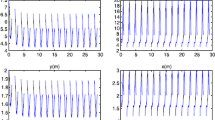Abstract
The purpose of this paper is to study the existence and global stability of a periodic solution for a discrete predator–prey system with the Beddington–DeAngelis functional response and predator cannibalism. By using the continuation theorem, the existence conditions of at least one periodic solution are obtained, and the sufficient conditions, which ensure the global stability of the positive periodic solution, are derived by constructing a special Lyapunov function.

Similar content being viewed by others
References
Jones, L.E., Ellner, S.P.: Evolutionary tradeoff and equilibrium in an aquatic predator–prey system. Bull. Math. Biol. 66, 1547–1573 (2004)
Volterra, V.: Variazione e fluttuazini del numero d’individui in specie animali conviventi. Mem. Accad. Naz. Lincei 2, 31–113 (1926)
Fan, M., Kuang, Y.: Dynamics of a nonautonomous predator–prey system with the Beddington–DeAngelis functional response. J. Math. Anal. Appl. 295, 15–39 (2004)
Beddington, J.R.: Mutual interference between parasites or predators and its effect on searching efficiency. J. Anim. Ecol. 44, 331–340 (1975)
DeAngelis, D.L., Goldstein, R.A., O’Neill, R.V.: A model for trophic interaction. Ecology 56, 881–892 (1975)
Cosner, C., DeAngelis, D.L., Ault, J.S., Olson, D.B.: Effects of spatial grouping on the functional response of predators. Theor. Popul. Biol. 56, 65–75 (1999)
Cantrell, R.S., Cosner, C.: On the dynamics of predator–prey models with the Beddington–DeAngelis functional response. J. Math. Anal. Appl. 257, 206–222 (2001)
Cantrell, R.S., Cosner, C.: Effects of domain size on the persistence of populations in a diffusive food chain model with DeAngelis–Beddington functional response. Nat. Resour. Model. 14, 335–367 (2001)
Hwang, T.W.: Global analysis of the predator–prey system with Beddington–DeAngelis functional response. J. Math. Anal. Appl. 281, 395–401 (2003)
Hwang, T.W.: Uniqueness of limit cycles of the predator–prey system with Beddington–DeAngelis functional response. J. Math. Anal. Appl. 290, 113–122 (2004)
Kohlmeier, C., Ebenhőh, W.: The stabilizing role of cannibalism in a predator–prey system. Bull. Math. Biol. 57, 401–411 (1995)
Bosch, F.V.D., Gabriel, W.: Cannibalism in an age-structured predator–prey system. Bull. Math. Biol. 59, 551–567 (1997)
Sun, G.-Q., Zhang, G., Jin, Z.: Dynamic behavior of a discrete modified Ricker–Beverton–Holt model. Comput. Math. Appl. 57, 1400–1412 (2009)
He, Z., Lai, X.: Bifurcation and chaotic behavior of a discrete-time predator–prey system. Nonlinear Anal., Real World Appl. 12, 403–417 (2011)
Fang, N., Chen, X.X.: Permanence of a discrete multispecies Lotka–Volterra competition predator–prey system with delays. Nonlinear Anal., Real World Appl. 9, 2185–2195 (2008)
Xia, Y., Cao, J., Lin, M.: Discrete-time analogues of predator–prey models with monotonic or nonmonotonic functional responses. Nonlinear Anal., Real World Appl. 8, 1079–1095 (2007)
Ghaziani, R.K., Govaerts, W., Sonck, C.: Resonance and bifurcation in a discrete-time predator–prey system with Holling functional response. Nonlinear Anal., Real World Appl. 13, 1451–1465 (2012)
Gaines, R.E., Mawhin, R.M.: Coincidence Degree and Nonlinear Differential Equations. Springer, Berlin (1977)
Fan, M., Wang, K.: Periodic solutions of a discrete time nonautonomous ratio-dependent predator–prey system. Math. Comput. Model. 35, 951–961 (2002)
Agarwal, R.P.: Difference Equations and Inequalities: Theory, Method and Applications Monographs and Textbooks in Pure and Applied Mathematics. Marcel Dekker, New York (2000)
Wang, W.D., Lu, Z.Y.: Global stability of discrete models of Lotka–Volterra type. Nonlinear Anal. 35, 1019–1030 (1999)
Sun, G.-Q., Zhang, G., Jin, Z., Li, L.: Predator cannibalism can give rise to regular spatial pattern in a predator–prey system. Nonlinear Dyn. 58, 75–84 (2009)
Li, L., Jin, Z.: Pattern dynamics of a spatial predator–prey model with noise. Nonlinear Dyn. 67, 1737–1744 (2012)
Sun, G.-Q., Jin, Z., Li, L., Li, B.-L.: Self-organized wave pattern in a predator–prey model. Nonlinear Dyn. 60, 265–275 (2010)
Zhang, X.-Q., Sun, G.-Q., Jin, Z.: Spatial dynamics in a predator–prey model with Beddington–DeAngelis functional response. Phys. Rev. E 85, 021924 (2012)
Sun, G.-Q., Jin, Z., Li, L., Haque, M., Li, B.-L.: Spatial patterns of a predator–prey model with cross diffusion. Nonlinear Dyn. 69, 1631–1638 (2012)
Acknowledgements
The research was partially supported by the National Natural Science Foundation of China under Grants (11171314 and 11147015), Natural Science Foundation of Shan’Xi Province Grant No. 2012021002-1, and the Program for Basic Research (2010011007).
Author information
Authors and Affiliations
Corresponding author
Rights and permissions
About this article
Cite this article
Li, L., Wang, ZJ. Global stability of periodic solutions for a discrete predator–prey system with functional response. Nonlinear Dyn 72, 507–516 (2013). https://doi.org/10.1007/s11071-012-0730-6
Received:
Accepted:
Published:
Issue Date:
DOI: https://doi.org/10.1007/s11071-012-0730-6



